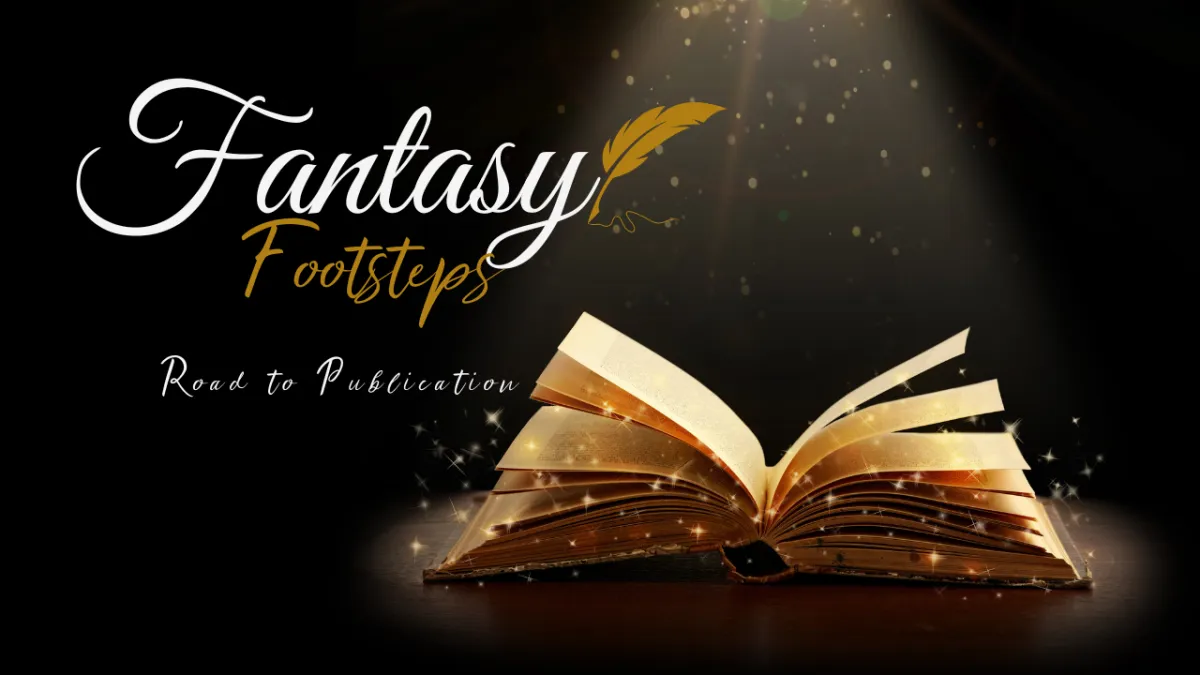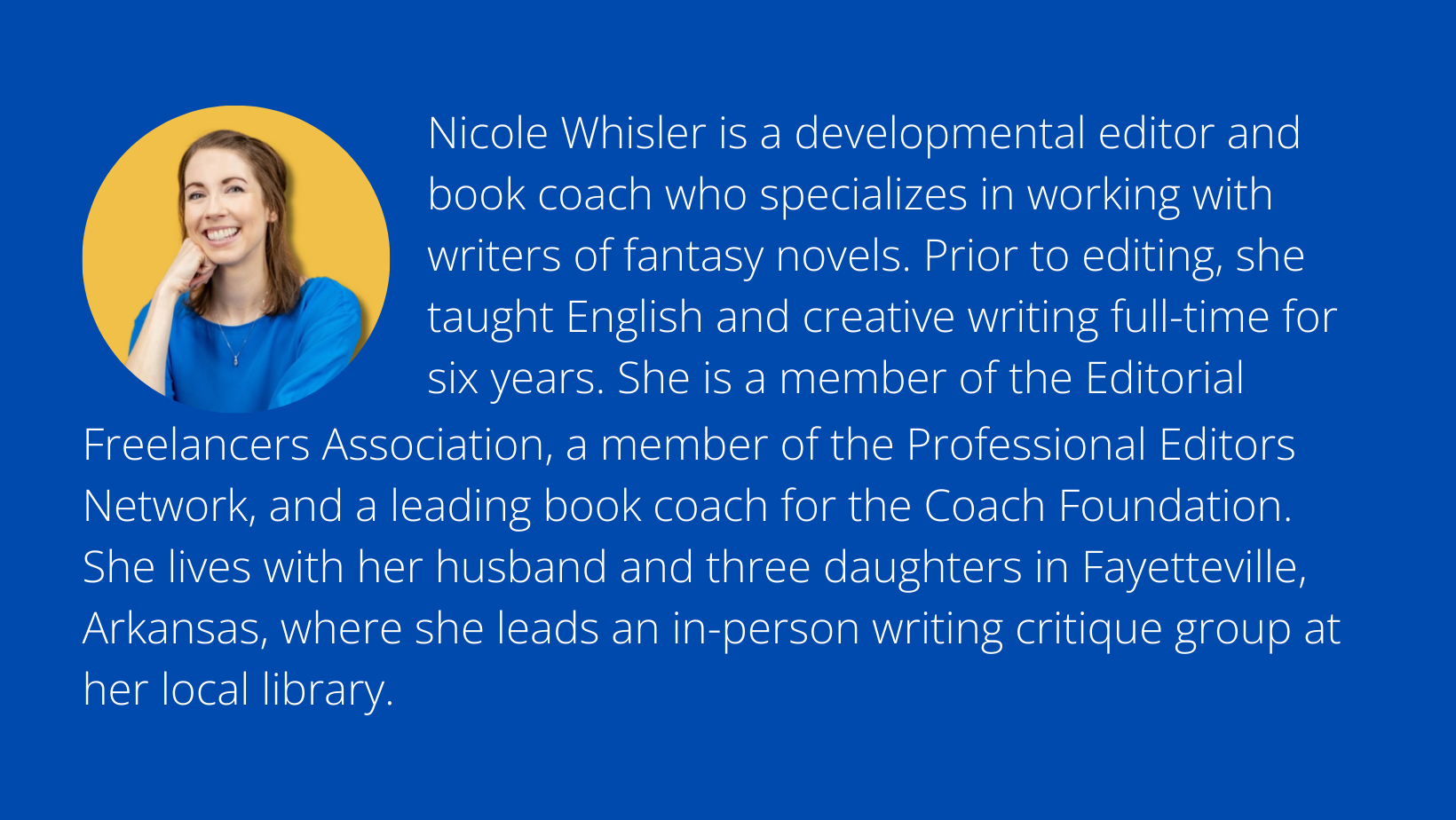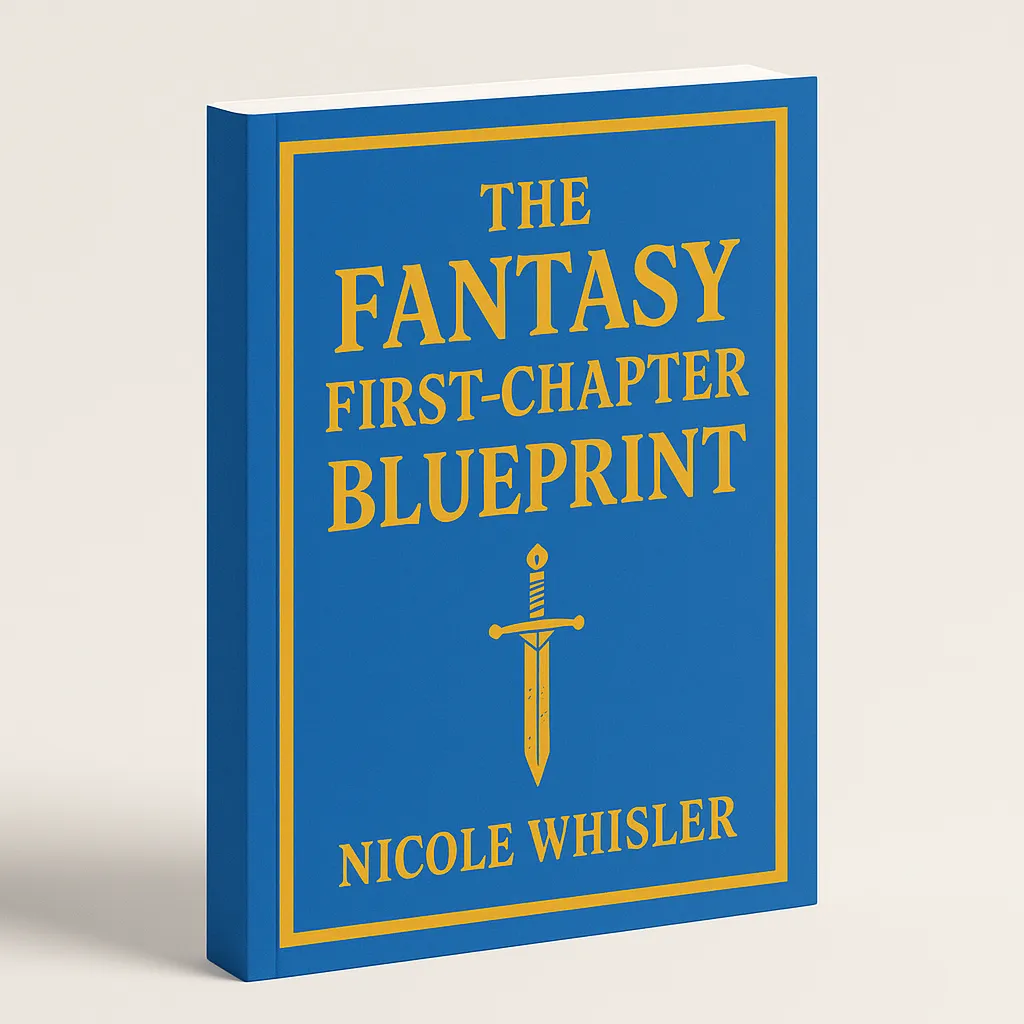The Fantasy First-Chapter Blueprint
Your first chapter is your one shot to hook an agent or a reader. Don't let the 7 deadliest mistakes land your manuscript in the rejection pile. This free 7-day email course gives you the step-by-step blueprint to avoid them and craft an irresistible opening.

Your Novel Matters ...
Looking for the right book coach for your fantasy novel?
Are you a fantasy writer …
… struggling to convert the vivid scenes of your fantasy novel from your imagination to the page?
… stuck in a loop where you constantly rewrite your opening pages?
… worried your story won’t resonate with your readers?
What if I could show you the exact steps week to week that would take you from brainstorming and drafting to revising and publication?
I specialize in developmental editing and book coaching for writers of fantasy novels—writers who value the craft of storytelling and wish to create stories that resonate.
My Services
Develop Your Ideas
Fantasy Footsteps: Road to Publication

I’ll let you in on a secret. All you need to succeed as a writer are three things:
A Roadmap: Illuminate your path with a step-by-step guide, ensuring you achieve your writing goals every week. From outlining to publishing, every stage of your journey is mapped out for success.
Mindset Mastery: Learn how your thoughts control your outcomes in your writing. Overcome self-doubt and unearth the confidence that will bring your unique ideas to life on the page.
Personalized Support: Prepare for comprehensive assistance, real-time accountability, and feedback tailored to your needs. From brainstorming sessions to final publication, you'll have a dedicated ally guiding you every step of the way.
With these three pillars, you'll unlock the potential to:
Craft a captivating story that enthralls readers from the first page to the last.
Develop complex characters and immersive worlds that resonate deeply with your audience.
Navigate the complexities of plot twists and pacing, keeping readers hooked until the final chapter.
Receive specific guidance on refining your scenes so that readers root for your protagonist.
Overcome writer's block and stay motivated throughout your writing journey, ensuring consistent progress.
Transform your rough draft into a polished, professional manuscript ready for publication.
Are you ready to turn your fantasy novel from a mere vision into a masterpiece that captures hearts and minds?
Join Fantasy Footsteps: Road to Publication and begin your author journey with everything you need to write a story that works.
Don't let your story remain trapped in your mind—bring it to life with me!
If you’re thinking, “Yes, please! Tell me what to do!” , I’d like to invite you to work one-to-one with me to finish your novel and write a story that works. Join my book coaching program designed specifically for fantasy writers—Fantasy Footsteps: Road to Publication.

Discover Helpful Tools
Resources For Writers
Here you will find some of my favorite resources for writers.
Add these books, podcasts, websites, and other resources to your writing toolbox to augment your writing at any stage.
Join My Free, Private Facebook Group
Finish My Fantasy Novel: Write & Revise My Best Book in 6 Months
In the group, I go live weekly with writing tips. The group is also a platform for writers to support each other and share their wins and progress.
Live training schedule:
1st Tuesday of the month: Free critique for someone in the group!
2nd Tuesday of the month: Writing sprint with fellow writers
3rd Tuesday of the month: Live training on a specific topic
4th Tuesday of the month: Interview with an author or marketing/business expert


Improve Your Craft
Writing Advice Blog
As a developmental editor and book coach, everything I post is designed to help you build your creativity, strengthen your prose, and explore new avenues in your writing. The opinions in each post are my own, but many are inspired by ideas from established authors and editors who excel in their fields.
Rely on my blog for clear and specific writing advice, motivational tips and grammatical aid, and interviews with experts!
Hi! I'm Nicole.
I’m a Developmental
Editor & Book Coach for Fantasy Writers.
Like you, I'm a writer. I understand the mental and emotional ups and downs of storytelling. Don't let resistance win! Recognize the value of good advice plus hard work.
My approach to novel writing is multifaceted. For a deeper understanding of my process and style, take a look at some of my favorite craft-of-writing books in my Resources section.
What can I say about myself? I read, I write, I read about writing, and I write about reading. It never gets old to me.

See what writers like you are saying . . .

Nadir Shirazi
“I’ve been stalling on my Islam-inspired sci-fantasy series for 10 years. But within 10 minutes of starting Nicole’s program, I started writing again."

Amanda Emerick
“I can’t recommend Fantasy Footsteps enough to writers who are legitimately looking to polish their craft, write, and eventually publish their novel."

Trinity Cunningham
“I loved discussing my story with Nicole. She provided me with invaluable insights I never would have considered on my own."
Latest on the Blog

You will find no pictures of kittens here. No images of favorite dessert recipes, snapshots of my recent vacations, videos of puppies playing the piano (although I do love dogs), or YouTube clips of monkeys stealing people’s sunglasses.
I’m genuinely sorry if that disappoints you.
Instead, you can rely on my blog for clear and specific writing advice, motivational tips, grammatical aid, and author/editor interviews.
As a developmental editor & book coach, everything I post is designed to help you build your creativity, strengthen your prose, and explore new avenues in your writing. The opinions in each post are my own, but many are inspired by ideas from established authors and editors who excel in their fields.
Some of these tips might be just what you need to hear. Others might not work for you personally, and that’s okay.
Apply the tips that fit your personality and writing habits, and feel free to adapt or ignore the others. For further questions and comments, you can email me or reach me through my Contact page.

How to Diagnose a Broken Scene
Discover in this post …
how to decide if you should cut or keep a scene.
four ways to diagnose a broken scene.
how to fix weak scenes.
Two Disclaimers
Disclaimer 1: Today’s topic is meant to be applied to second drafts. As a book coach for fantasy writers, I always advise my clients to get to the end of the first draft before worrying about perfecting their scenes and arcs. But if you’re here to collect nuggets of wisdom, I won’t turn you away! You can apply the advice below to any scene that isn’t pulling its weight.
Disclaimer 2: I believe all scenes can be fixed. But occasionally, if the scene isn’t contributing to the global story, I do consider it a “fix” to remove the scene altogether.
Your Story Chain

Say you have a “problem scene” in front of you, one that’s been bothering you for ages. You’ve tried to resolve the issue, but at the same time you’re not clear on what the issue is. How do you determine whether it’s better to fix that scene or remove it altogether? Here’s what I recommend:
1. Decide if the scene in question pushes the story toward your protagonist’s global goal. Does the scene create momentum that brings your protagonist closer to what they ultimately want? It’s also okay if your protagonist gets farther from their goal, but the scene should relate to the goal in some way.
Think of your story as a chain with many different links. If one link is broken, readers will notice that something seems off, and your story won’t be as effective as it could have been if you had fixed that broken link. (By the way, if you’ve finished your first draft and you feel like the pieces of your story aren’t connected by any links in a chain, that’s okay! The purpose of your first draft is to get it down on paper. It’s only when you gain a bird’s-eye view that you can truly step back and examine your work as a whole.)
Remember that not only should you yourself know how your scene pushes your story forward, but readers should see this too. Sometimes your reasoning is clear in your mind and you could explain the connection if someone asked, but unless that connection is on the page, readers won’t necessarily understand the link. To fix this problem, make sure the scene’s key events immediately impact the story—or that you at least hint at the implications.
2. Decide if the scene should stand on its own or if you should integrate it into another scene. Do you need an entire scene to express the plot point you’re conveying, or can you merge that plot with the content of another scene?
For example, some writers struggle with transitions between important events. Perhaps your protagonist is on a journey, and although the setting changes, not much happens for three scenes in a row. Consider whether you might summarize anything you want readers to know (yes, tell instead of show) and transform those three mediocre scenes into one tight, effective scene.
As another example, perhaps your protagonist meets a minor character for the first time. Instead of using an entire scene to describe their meeting, you might have that scene pull double duty so that it serves more than one purpose.
Now let’s assume you’ve run your scene through the tests above and determined that a) the scene needs to be included in your overall story and b) the scene needs to be shown rather than told. If both items are true, that means we can get to the fun part! Let’s discuss the meat of this post and diagnose what could be wrong with the scene.
4 Ways to Diagnose a Broken Scene
The four items I’m about to go over occur in order from the biggest possible fixes to the smallest. If something is wrong with item #1, for example, I recommend making that correction before moving on to examine whether #2 is on track.

#1: Check for goal, conflict, and stakes.
First, identify your character’s goal that moves the story forward. This can be shown through context, so you don’t need to awkwardly spell out the goal on the page (“Clarissa intended to find her missing book of spells that day,” etc.). The context should reveal what your character wants. For example, maybe it was clear from the previous scene that Clarissa arrived at her uncle’s house and now intends to subtly discover whether her uncle might have taken and hidden her spell book. If it wasn’t clear, you can easily imply this through dialogue and/or Clarissa’s thoughts. If readers don’t understand what Clarissa is trying to do, they won’t understand why the events matter to her, and if it doesn’t matter to Clarissa, readers won’t care if the goal is met.
Next, check for conflict. Often, writers assume that conflict refers to anything negative that happens in a story, but this isn’t necessarily the case. Conflict should relate, either directly or indirectly, to the global goal and can be defined as what gets in the way of the character achieving their scene goal.
Last, check for stakes. Stakes are consequences that show why the conflict matters. What happens if your protagonist fails? What new difficulty will they face if they don’t achieve their goal in the scene? Readers should understand why obtaining the goal is essential.
Let’s look at a quick example to pull #1 (goal, conflict, and stakes) together. Perhaps your protagonist’s scene goal is to win a magic contest. They’ve been practicing hard, and they’re skilled at what they do. Be sure to consider the following two items as you plan, write, or strengthen your scene:
Winning the magic contest should relate to the global story goal in some way. It shouldn’t be a tangent (a contest for the sake of some random excitement!), or you’ll lose readers because they won’t grasp why the contest matters.
Choose your conflict carefully. Barely winning the contest after some difficulties will produce a different effect from losing the contest altogether. Losing the contest changes the character’s path, which creates that cause-and-effect chain that appeals to readers. Readers love change and unpredictability, so depending on the effect you’re going for, losing the contest might be the more compelling option.
So as you examine your problem scene, start by checking for a scene goal, clear conflict that gets in the way of that goal, and stakes that show why achieving the goal matters. If your scene contains all three, congratulate yourself and move to the next item that might be weakening the scene:
#2: Check for a value shift.
As I’ve mentioned, stories are ultimately about change. A value shift is simply a term (used by editor Shawn Coyne) that expresses that change through specific words. Scenes shift along a spectrum of human values, such as life/death, selfishness/self-sacrifice, or success/failure. In a fight scene, the value might change from healthy to injured. In a love story, perhaps a scene shifts from mutual dislike to subtle attraction. The possibilities are endless. You get to choose the words! Readers won’t approach you and say, “I really admired the value shift you included in your opening scene.” But they might compliment you on the power your story held over them, or the way you affected them emotionally.
Value shifts should impact characters and typically have to do with the emotions present in the scene. How do your characters feel at the beginning vs. end of a scene? How do they respond emotionally to the story’s events?
Often, a value shift will relate to character expectations. Perhaps your protagonist intends to blackmail another character, and they enter the scene with confidence, thinking they have the upper hand. By the end of the scene, however, readers learn that the second character has worse dirt on the protagonist, thus turning the tables. To put this into words, we might say your protagonist’s emotional state has shifted from confident to disheartened. You could also use the terms winning to losing. Again, the wording itself doesn’t matter, but it can help us pinpoint the change—and make sure it’s present—as we revise and strengthen our scenes.
You can express value shifts not only with words, but also through the polarity of the shift. Scenes can shift in four ways:
Positive to Negative (+ to -) (A scene begins positively but ends negatively, as in my example above.)
Negative to Positive (- to +) (A scene begins negatively but ends positively.)
Positive to Double Positive (+ to ++) (A scene begins positively and ends in an even more positive way.)
Negative to Double Negative (- to - -) (A scene begins negatively and ends in an even more negative way.)
Notice that no matter how the scene is structured, it should change in some way. As I’ve said before, change—or at least the potential for change—is what draws readers into a story and makes them eager for more.
If there’s no value shift, add one to make sure there’s a clear change! If in doubt, ask yourself how you want the scene to change.
#3: Check for structure.

The third item that can help you diagnose what’s wrong with your scene relates to your scene’s structure. (Generally, a “scene” refers to an arc of change in your novel that contains a beginning, middle, and end. It often takes place in the same setting with the same characters. Most of us have an instinctual understanding of the term “scene.” We might easily call to mind George R. R. Martin’s Red Wedding scene, for example, or Harry’s fight against the Hungarian Horntail in the Triwizard Tournament.)
Make sure your problem scene needs to be present in your overall story—because there’s no sense analyzing its different parts if you end up cutting the entire scene later. But assuming your scene fits into your novel as a whole, check that these core ingredients aren’t missing:
Inciting Incident = the item that upsets the beginning balance of your scene
Progressive Complication(s) = the events that make things better or worse for your point-of-view character, escalating until they force your character into a choice
Crisis Question = the question that reveals the difficult choice your character must make between two or more items (typically two equally positive options or two equally negative ones)
Climax = the answer to the crisis question (Which option does your point-of-view character choose?)
Resolution = what changes as a result of your character’s response to the crisis question
For a full example of how the five story commandments play out in a working scene, consult my past blog post “How to Write a Scene That Works.” I’ll include a mini-example below as I discuss #4, which expands upon #3.
#4: Sharpen the turning point.

The turning point of your scene is the “moment of change”—the action or realization that shifts your scene from one emotional state to another. (Remember the value shift?) In other words, the turning point is the final progressive complication that pushes your point-of-view character into facing the crisis question and making a choice.
A scene can turn on action (something happens) or revelation (new information comes to light).
As promised, here’s an example to help you understand how to identify and sharpen your problem scene’s turning point. Let’s say that at the beginning balance of your scene, your protagonist is on the run from your antagonist and is camped out in the woods. Here’s how the five commandments of a working scene could play out before you sharpen the turning point:
Inciting Incident = Your protagonist is found out. The antagonist is coming after them, and they’re close!
Progressive Complication(s) = Your protagonist hasn’t eaten in a day or two, so when they try to escape, they discover they’re too weak. Maybe they have a specific power that isn’t working. And maybe they were hiding out with a sidekick, but that sidekick is gone because they went to find food, so they have no help.
Crisis Question = Should your protagonist try to escape without their sidekick, or should they attempt to fight the approaching antagonist?
Climax = Your protagonist fights!
Resolution = Your protagonist loses and is captured.
Now let’s look at sharpening the turning point in the example above. First, identify the turning point as it stands. To do this, look for the trigger that pushes your protagonist into making their decision (climax). Why does your protagonist decide to fight?
In my example above, there is no clear trigger. The protagonist has a choice and decides to fight, but readers aren’t given any insight into why the protagonist chooses to fight rather than run.
To sharpen the turning point, include a clear reason. It can be anything. Maybe the antagonist insults a family member, friend, or relative close to your protagonist. Or maybe the antagonist walks out with the sidekick, signaling they’ve already captured them. That can be the final straw for your protagonist. Perhaps your protagonist planned to run, but once they see the sidekick, they want to stay and fight to get their friend back.
Intensifying the difficulty of the choice can help keep events unpredictable. If the choices are to run and escape vs. to stay and fight, you can complicate the situation by adding some creativity. What if your protagonist doesn’t like the sidekick character? What if they’ve annoyed each other and argued for the majority of the novel? That makes the choice more difficult. Instead of easily deciding to stay and fight, your protagonist must now ask, “Do I stay and save this person I don’t like because it’s the right thing to do, or do I escape and keep my life?”
The choice your protagonist makes will say a great deal about them as a character, not to mention that the act of making a choice will keep your protagonist proactive. Readers discover who characters are at their core through their thoughts and decisions. You can tell readers about your characters all day long, but the choices your characters make will reveal much more.
Sharpen your turning point by including your protagonist’s motivations and thoughts on the page, and readers will root for that character as they continue on the path toward their global goal.
As a recap, today I discussed four ways to diagnose a broken scene. Here they are one more time, along with their fixes:
Check for goal, conflict, and stakes.
THE FIX: Add these items to each scene if they’re not on the page (can be direct or implied).
Check for a value shift.
THE FIX: Add a value shift (a clear change) if it’s missing. Ask yourself how you want the scene to change.
Check for structure.
THE FIX: If any of the five commandments of a working scene is missing (inciting incident, progressive complications, crisis question, climax, or turning point), put it on the page!
Sharpen the turning point.
THE FIX: If your point-of-view character’s decision is too easy, or if you haven’t conveyed the reason behind the choice, increase the difficulty of the decision and/or get into your character’s head so that readers know who your character is and what they stand for.
When you deal with a problem scene, remember to start at the top of this list and work your way down—and if you’re writing your first draft, finish it first! You can’t edit what isn’t written. Once your draft is complete and you have a bird’s-eye view of your story, you can add, rearrange, cut, and analyze to your heart’s content.
Do you want to learn how to write a story that makes your target readers stand up and cheer? If you’d like support from A to Z (from brainstorming to drafting to revising to publication), book a Discovery Call with me to see if you’re a good fit to join my book coaching program, Fantasy Footsteps: Road to Publication. And if you haven’t done so already, grab your Free Guide on how to hook readers from your story’s start!

Capture Your Readers from Your First Scene
Get my exclusive blueprint—7 Mistakes to Avoid in Your Fantasy Novel’s Opening. Start your fantasy novel right!
Are you worried you've failed to establish a bond between readers and characters in your first chapter? Do you wonder if you've bogged readers down with your worldbuilding? Do you sometimes overlook essential conflicts? Many readers will put your book down if it doesn't grab their attention right away, so it's vital to evoke powerful emotions from readers as early as possible.
Don't let these common mistakes rob your story of its magic and momentum. Save your precious time and energy by ensuring you hook readers from the start. Grab your guide now and check your opening against these common missteps!
(You will also receive monthly writing advice, updates about my free live trainings, and direct access to replays. Unsubscribe anytime.)

